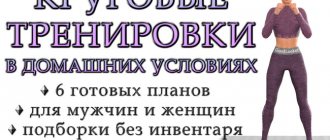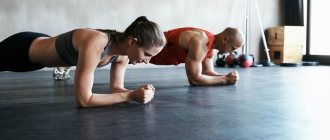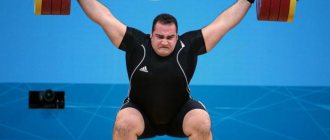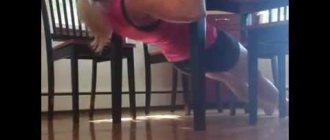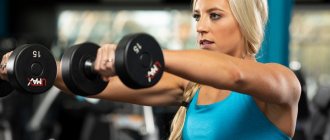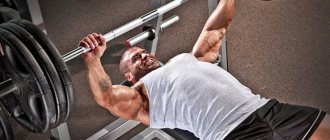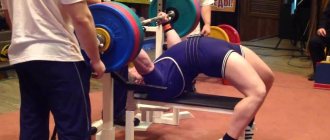June 6, 2016 Admin Home page » Tips and recommendations
Find out how to use strength training with iron to increase your punching power and develop speed, using only effective tips and tricks.
Recently, a lot of people have begun to engage in martial arts, from classic boxing and kickboxing to more advanced levels of martial arts, with the exception of MMA and M-1.
However, people have the idea firmly stuck in their heads that any increase in muscle mass when working with iron will definitely reduce the speed and coordination of movements, but strength training for fighters is an important aspect of sports training. Of course, if you work purely according to the scheme of a bodybuilder or powerlifter there will be negative things, but if you approach the matter wisely, the results will only go up, which is why strength training for fighters is a very important aspect in the training of professional athletes.
Strength training for fighters
Since the times of the USSR, people have firmly believed that iron is the number 1 enemy of any martial arts, but let's look at examples:
- Bruce Lee is probably one of the most striking examples; he not only practiced punches and performed stretching exercises, but also actively used weights even when he studied with a teacher in the monastery.
- Oyama Masutatsu is the founder of Kyokushin karate, many martial arts fans know about the speed qualities of his bull strikes, but few people know. that he honed his technique while working out with a barbell.
- Sergey Badyuk - they once asked him if it was true that iron weakened you as a fighter, to which he replied with a smile, let those who doubt it come and check how much my technique and blow have weakened.
Let's take a look at modern MMA fighters as an example - Fedor Emelianenko, Mike Zambidis, Alistair Overeem, Brock Lesnar, Antonio Silva, Junior Dos Santos - the list goes on for a very long time, they had an excellent athletic physique, and at the same time they had the strongest blows, while simultaneously practicing strength training with iron.
Proper use of gym iron helps increase punching speed and power.
Using elastic bands for specialized training
A wrestling harness can serve as an excellent tool for practicing boxing and wrestling techniques.
Exercises for practicing punches
The loop of the tourniquet is attached to a fixed support at the level of the shoulder girdle, and the other end is held in the fist. From the initial “fighting stance” position, various blows are simulated, with low rubber tension.
Example of a program for practicing strikes:
- Jab – 3 sets of 12 reps;
- Uppercut – 3x12;
- Straight – 3x12;
- Hook – 3x12;
- Squats with a harness – 5x20.
Exercises for practicing throws
Depending on the athlete’s skill level, a set of exercises with wrestling rubber allows you to select the most effective techniques at each stage of improving skills. Rubber can be used both for practicing element-by-element throwing techniques and as a virtual opponent.
Basic rules of strength training for developing strength and speed
- Do a variety of exercises, even use ones you don't like.
- Before working with heavy weights, you need to warm up your muscles well with light weights.
- When working with weights, use cheating.
- When lifting weights at an explosive pace, always use decent weights, approximately 70% of your one-rep max (this is the weight at which you can only do 1 repetition and no more.)
- All exercises are performed at a fast pace.
Strength training for fighters manifests itself in the mistake that many use the same type of exercises, without thinking about the fact that our body gets used to the loads, and this is a brake on the growth of results, so you need to add variety to the exercises.
Recommendations from experienced athletes
Swede Alexander Gustafsson and British fighter Tom Watson shared the secrets of their training for MMA fighters.
Strength training consists of the following principles:
- Load on all muscles of the body. In mixed martial arts, the principle of destroying the enemy always works. In such a “meat grinder”, each muscle must show its strength. Fighter Tom Watson believes that gymnastics rings are better suited for this. Not all athletes who can bench press train with gymnastics rings. These exercises work even those muscles that the fighter is not even aware of. If there are no rings in the gym, perform push-ups with support from the TRX loop.
- Visiting the pool after training. Water helps remove breakdown products faster. Swimming is the safest sport for the spine; it is the best way to relax your muscles after working out in the gym. Gustafsson recommends swimming 200 meters first, followed by 4 sets of 30-second stretches for the hamstrings. Afterwards, run for a couple of minutes, standing in chest-deep water, then for one minute do shin overlapping and hip extensions, twisting in the water. This promotes the rapid removal of waste products from the muscles. Recovery after training is faster.
- Simple food. Tom Watson recommends eating a lot of vegetables and a little less meat. When cooking, use a minimum amount of ingredients and create a simple menu. Of the approved sports supplements, the fighter prefers products with a simple composition. He uses them throughout the day as needed.
- Weight control. Athletes lose weight before a fight. To move to other weight categories of martial arts, they recruit. In preparation for a fight, Gustafson loses up to 14 kg of his own weight so that his body weight does not exceed 100 kg. The athlete has his own secret to losing weight - almond oil. 2 - 3 spoons in the morning, during the day before meals and in the evening before bed will provide the body with the required amount of calories and maintain shape. Muscle mass will not be affected when losing weight.
- Using simple training methods. Professional mixed martial arts fighters do not use special myostimulation suits. Tom Watson recommends three basic exercises: the clean and jerk, the snatch, and the clean. The athlete prefers light programs and claims that classic weightlifting exercises are more effective.
A set of exercises for strength and speed
These exercises are used by many MMA fighters, you too should use them, and later compare the results:
Workout #1
Muscle stretching for 10-15 minutes
- Dumbbell Bench Press – 6 sets x 15,12,10,8,6,4 reps
- Incline Bench Press – 3 sets x 10 reps
- Dips – 3 sets x 10 reps
- Barbell Hip Raise - 3 sets x 10 reps
- Military Press - 3 sets x 10 reps
- Raising the torso – 2 sets x maximum
Rest between repetitions for 2-3 minutes, do not forget to breathe correctly - exhale as you force, inhale as you relax.
Workout #2
Stretching for 10-15 minutes
- Deadlift - 3 sets x 10 reps
- Pull-ups - 3 sets x 10 reps
- Bent-over dumbbell rows - 3 sets x 10 reps
- Standing barbell curl - 3 sets x 10 reps
- Bent-over dumbbell raises - 3 sets x 10 reps
- Hanging leg raises - 2 sets x maximum
Workout #3
Stretching for 10-15 minutes
- Leg press - 3 sets x 10 reps
- Lying leg curls in the simulator - 3 sets x 10 reps
- Standing calf raises - 3 sets x 10 reps
- Lunge Snatch - 3 sets x 10 reps
- Jackknife exercise - 2 sets x maximum
Subscribe to groups on social networks (VKontakte, Odnoklassniki, Facebook, Twitter, Yandex Zen), it’s very easy to find us, just write BOMB BODY in the search for the desired group!
Muscle diagram and training days
The complex for the development of mass and speed will last 6 weeks, and classes will alternate like 4/7 and 3/7. Thanks to this distribution over training days, the athlete’s muscles will have time to rest in order to grow. Each muscle group will be loaded once a week, and the scheme itself looks like this:
- Workout A – Chest, Triceps and Delts
- Workout B – back, biceps and rear deltoids
- Workout B – Full Legs
The abs are not included in this list because they are toned at the end of each workout.
Where is the best place for MMA fighters to train?
When choosing a fitness center for training, pay attention to the Gold's Gym chain of clubs. Over 20 years of work in Russia, this brand has established itself as a close-knit team of professionals. Modern sports equipment, the latest training programs, attentive attention to each visitor - all this can be found in Gold's Gym clubs. Martial arts classes are regularly held here under the guidance of experienced trainers. You can study both in a group and individually. If you are only interested in training in the gym, then new multifunctional exercise machines and consultations from qualified instructors are at your service.
By developing their body and sports skills at Gold's Gym, fitness enthusiasts and professionals also improve their spirit and become members of a large and friendly family.
THIRD LOAD OPTION (Reduce time to complete a given amount of work)
You have a total number of reps to complete for each exercise.
For example like this:
- 100 pull-ups
- 200 leg raises (abs)
- 200 push-ups
- 400 jumps with alternating legs
Please note: this is not the number of repetitions per exercise of the round. This is the TOTAL number of reps added up (for all the rounds you will do).
How many rounds (circles) should there be then? The peculiarity of this method of loading is that you decide how many circles (rounds) to do! You only have the TOTAL number of repetitions of the exercise that you need to do in total (in all circles) in total. It doesn’t matter how many circles you get. At least do one repetition per circuit exercise if you want. But remember that this load is FOR TIME, and with such a strategy you will lose it.
Basically you start with pull-ups. When your strength runs out (let’s say at 9 repetitions), you do not rest in order to complete the planned number of repetitions in the approach (there is no such number with this method). Instead, you move straight to the next exercise...then the next...until you get back to pull-ups. And here you start counting not from the 1st repetition, but from the 10th (because you have already done 9 before). Let's say you did 8 repetitions. This means that in total you will have, you will continue to count from the 18th repetition, etc...
WOD #3:
- 100 jump rope
- 10 pull-ups
- 10 leg raises to the horizontal bar
- 10 push-ups
- 10 burpees
Objective: do the maximum number of rounds in 20 minutes.
How to do it:
Advanced athletes can perform this routine with weights or wearing a vest. Perform pull-ups with kipping, since a fighter needs an “explosion” and not pumped up muscles. Raising your legs to the horizontal bar is also best done by kipping.
In push-ups-off, at the lowest point we lie with our chests on the floor and for a split second we lift our palms off the floor, after which we straighten our arms and move to a lying position. Burpees can be done standard - with a jump and clapping your hands above your head, or you can replace them with any of the options: with a high jump and touching your knees to your chest, with throwing a “2” into the air, etc., etc.
MMA fighters who include CrossFit routines in their training show good endurance in professional and amateur fights.
We wish you productive training and new victories! In contact with
Crossfit training system for mixed martial arts.
If you want to try doing this, you can try it with your entire training program, or within one exercise. If you want to train like this in one exercise, then choose an exercise and warm up. Then, within 10 minutes, try to do as many repetitions as possible. Choose a weight that you can do 12-20 times with, depending on whether the emphasis is on strength or general endurance. During exercise, plan your work and rest times to get the most out of it. From week to week, increase the number of repetitions during this time. Recommended duration 6 weeks. The first 2 are in easier mode.
If you want to try this principle throughout the entire program, then conduct the workout in test mode and record the time. Then you start practicing according to this principle. Make sure not to spend more time than you initially had and gradually add repetitions per set, starting from the last sets of the exercise to the first. The second option is to start studying, for example, for an hour, and every week try to cut the time by 2-3 minutes. And the third option - fix the time according to the principle described in one exercise, do not take into account warm-up and rest, but make sure that this time does not change much. The first 2 options are convenient for those who train in the classic CrossFit style, the third, who trains in a more powerful version. I recommend no more than 6 weeks. The first 2 weeks are lighter to prepare the body.
Key aspect of the training
What determines whether we will get results from training according to a specific scheme? Set of exercises, volume of loads, intensity. Of this, the most difficult thing is to choose exactly the right intensity. A set of exercises is easy to select, depending on the task. And the volume of loads depends on the intensity. If you exercise too hard, your body will be overloaded and there will be no progress. If the intensity is too low, there will be no progress because the stress is insufficient.
crossfit.lv
What is the best way to choose the right intensity and, in relation to it, select the desired volume and number of workouts? For basic training, I recommend the following - train the whole body every workout 3-4 times a week. At each lesson, one group is taken as the main one - hard, the rest are medium or easy. Moderately hard training is used to train non-target groups, and light training is used to train the central nervous system, improve movement technique and improve recovery. I recommend doing each group 2 times a week - hard/easy for the main ones and medium/medium for the auxiliary ones. The auxiliary ones are usually arms, shoulders, calves, abs. Unless, of course, there is a goal to train them specifically. Only do deadlifts once a week or even once every 2 weeks.
How hard is it to train during heavy training? For the upper body, I recommend doing 6 working sets in the base for the main group with a number of repetitions of 5-6, and another 1 isolating set in 3 sets for 8-10 repetitions. On the bottom – 3-4 working sets. Legs require heavy weights, so the stress on the nervous system is noticeably higher. The load is such that there is no need to reduce the weight of the projectile. Do this for 6 weeks, then 2-3 weeks with higher intensity. You leave 3 working sets for the upper group, 2 for the lower group, but the maximum effort is in the last set, make easy workouts even easier, cut back on the support. During intensive weeks, try increasing the weights each week. It is advisable to plan this in advance so as not to overload yourself too much during the first intensive session. Intense workouts last as long as you can add weight. After a week you rest and start training volumetrically again, but the weights are already higher.
The second way to choose intensity is to start with 50% of the one-time maximum, perform in 3 sets of 10 repetitions and every week add weight and reduce the number of repetitions. In about 12 weeks, it is advisable to reach a record and get 105-110% of the previous maximum. All submarine methods are based on this principle. The downside is that not everyone makes progress on this. If you can’t progress like this, then you’re unlikely to become an eventing champion.
Crossfit with kettlebells
We present to your attention a simple set of exercises with weights. It is often believed that a kettlebell is almost the same as a dumbbell, but in reality the situation is somewhat different. Some exercises with weights and dumbbells are uncomfortable and traumatic. In addition, kettlebells are a separate sport, unlike dumbbells. The differences between kettlebells and dumbbells are a shifted center during exercises, a thicker handle, which makes the grip stronger.
The advantages of kettlebells are that the apparatus is simple, convenient, can be used for many exercises, and inexpensive. Kettlebell snatches and swings are very effective exercises for developing power and explosiveness. They cannot be replaced with other shells.
CrossFit complex with kettlebells, designed to increase general physical fitness Day 1
1) Squats with kettlebells + standing press of two kettlebells *10 2) Taking 2 kettlebells on the chest *10 3) Row of 2 kettlebells to the belt *10 4) Lifting one kettlebell with two hands on the biceps *10 5) French press standing with one kettlebell from - for heads *10
* Exercises are performed one after another without rest. 5 working sets.
Day 2
1) Push 2 kettlebells 5*10 2) One-arm kettlebell snatch 5*10 3) 2-hand kettlebell swing to chest level 5*10 4) Farmer’s walk with 2 kettlebells – 200m. *Perform the first 3 exercises with a pause of 2 minutes between sets. Strive to increase the number of repetitions by reducing sets. First, 5*10 is performed, after 4*13, 3*17, 2*25...
The complex is performed 3 times a week, every other day. It turns out that odd weeks are 1, 2, 1 days, even weeks are 2, 1, 2 days. In the middle of the week, take a lower-impact day. Use lighter weights. If there are none, then fewer repetitions or sets.
Day
Cardio workout. Choose a distance, 3 km to start, try to increase it to 5 km over time. After running, exercise with a jump rope.
3. day 1) Front row of dumbbells 5*12 2) Row of dumbbells to the waist 5*12 3) Incline dumbbell press (if there is a bench) 5*12 4) Jumping squats 5*10 5) Scissors with dumbbells (weightlifter) lunge option) 3*10 6) Leg raises lying on the press 3*20 7) Calf raises (the easiest way to do this is on one leg, as it will be easy to take a dumbbell) 3*15
Day 4 Cardio training, the same as on day 2, but the load is 15-25% lower. Reducing your load is important for recovery.
Notes: *Always start your workout with a warm-up. Before each power movement, be sure to do the same with a lighter weight. * The intensity of the strength exercises is such that you can complete all the repetitions. You only need to come close to failure in the last set. *Rest 2 minutes between sets. Try to keep it to 1 minute. It is especially important to reduce rest time if your weight gain is limited.
Conclusion: the program is simple, its task is to lay the foundation for subsequent training. Do this for 3 months, after which you can move on to a more advanced scheme.
Crossfit training system for mixed martial arts.
Today I want to talk a little about the CrossFit training system. Many have heard about it, seen it, and someone is already training according to this system, but there are people who are little familiar with CrossFit and have no particular idea what it is.
Crossfit is a new mass sports hobby that first “got sick” in the USA, and then “infected” the whole world. The main idea of CrossFit is the general physical preparation of a person, preparing the body for any life situations. CrossFit combines training for strength, strength endurance and speed. Various types of martial arts, especially MMA, have also become susceptible to this sporting hobby. In essence, CrossFit is circuit training, i.e. Exercises performed in a circle without a break. More precisely, the approach of one, then the approach of another, then the approach of a third, etc. A full circle is one approach. On average, from 3-5 exercises to 6-10 are used.
All kinds of CrossFit competitions are held in Russia, and stars of domestic sports from weightlifting to mixed martial arts actively take part in this. In Russia, CrossFit is supported by Reebok, and they are the first organizers in Russia.
But competitions are not the main thing; the most important advantage in the entire CrossFit system is the development of all the necessary qualities for a mixed-style fighter: strength, endurance, speed - what else is needed? To make it clear, I will list several basic exercises that mixed martial arts fighters use: - Running from 2 to 20 km - to develop endurance, used as a warm-up in the training process. - push-ups with clapping from 10 to 30 times - development of arm strength and speed by pushing from the surface and balancing your body - sledgehammer - a well-known universal exercise aimed at all muscle groups, using a weight of 20 kg. The athlete hits a car tire with a sledgehammer, thereby forcing the muscles of the arms, back, abs and legs to work. - jerk with a kettlebell - generally not used by all athletes in order to avoid injury. Targeted exercise for arm and back strength. — squats with a barbell — develops the strength of the legs, back and entire muscle corset. — jumping from a place develops both leg strength and speed. And these are not all the exercises that fighters use in their training process.
Classics used in martial arts - squats, push-ups, press or squats, push-ups, pull-ups, press. This option is ideal for halls and sections where there is no special equipment and hardware, as well as for the home. In my young years, when I was doing karate, the squat-push-press option (plus running with and without acceleration and with and without punching) was the only and main option for CrossFit. True, in the early 90s we didn’t know that it was called that J
There are many variations of CrossFit, as well as a range of exercises used. Athletic crossfit is very popular, i.e. CrossFit, which uses only (or mostly) weight training. Of course, mostly basic, multi-joint exercises are used. Bench press (and/or push-ups), pull-ups (or rows), standing press (kettlebell, barbell or dumbbell) and squats are some of the most common athletic CrossFit variations. Sledgehammer and running are often added. There is even a version of powerlifting CrossFit, where you alternate between squats, bench presses and deadlifts. Such training is done once a week to avoid injury and overtrain the muscles. It should be noted that the load on the cardiovascular system in this mode is colossal!
So be careful not to overload! Weights (if you use weights), sets, repetitions, everything should be increased gradually. You need to start with light loads. For example, no more than 2-3 circular approaches. And as your training level increases, gradually raise the “bar”. Rest between circles, on average 1-3 minutes, if it’s hard, up to 5 minutes. See how you feel. My friend, with 25 years of experience in bodybuilding and powerlifting, is no stranger to martial arts (that is, he is no stranger to hand-to-hand combat), we will decide to try the newfangled CrossFit regime, having watched enough programs with Sergei Badyuk. He did only one workout (about 5 exercises), but went overboard with the weights. In fact, I almost grunted afterwards, my heart sank so much. Moreover, it didn’t just grab me, but for a week. He left for a long time afterwards. The desire to experiment, however, quickly passed. So, I repeat again, be careful not to overdo it! Graduality and more gradualism!
Some trainers shared their CrossFit training tips:
Plaksin Igor - coach of the K-4PRO club (St. Petersburg)
CrossFit is a very good pre-fight training system. We don’t have standards in the training process; I develop everything for each fighter, taking into account the preparation and date of the fight. We begin to work as universally as possible about a month before the fight, taking into account rest, but with an emphasis on endurance. For example, if the fight will take 2 rounds, we prepare for 3-4 rounds, depending on our endurance. We work on strength qualities with the help of exercises such as sledgehammers, exercises with weights, and weights. But every coach must understand that this is all so individual that it can no longer be used for two fighters.
Vitaly Bigdash is the coach of the Rostov team Peresvet Fight Team.
I have been using this system in my training process for a long time. For fighters who participate in tournaments, I prescribe training individually, but as a basis I take the transition of strength exercises to cardio, so that the fighter does not load all the muscles before the fight and works more on endurance. There are standard exercises that have proven themselves and are more effective for mixed martial arts fighters - these are ropes, a sledgehammer and a car tire. I recommend these exercises to all athletes, as they develop almost all muscle groups. Ropes develop the strength of the arms and shoulder girdle, working with a sledgehammer develops the strength of the abs, back, legs and arms, naturally, and working with a tire works the legs, abs and arms.
Physical training in martial arts. Part one. Start.
In the first article we will look at what goals are set when training fighters, how their training differs from other sports and what tools we will use for this. In the following, we will draw up approximate plans to achieve the required results.
Goals:
- increase in strength indicators in relation to the type
- increasing specific endurance
- speed development
- improved coordination
- accelerated recovery
In simple terms, the tasks boil down to ensuring that the fighter: moves quickly, delivers strong blows/throws, can maintain a high pace for a long time, and recovers quickly. What does this require?
Increase in strength indicators. Different activities require different strengths. Striking sports require a different strength than that required to lift a heavy weight. It can be compared more to throwing an object rather than lifting a heavy barbell. What is required first is the development of maximum acceleration. To fight, it is necessary, first of all, to develop power, since you have to work with the enemy’s resistance. Explosive force is also necessary. Tools: strength exercises in a forceful and explosive manner, as well as specific exercises for the desired type.
Increase specific endurance.
The goal is to ensure that the fighter can maintain the required pace in the ring, tatami or wrestling mat. This is exactly what we need to start from in order to develop the necessary qualities. A common mistake is that to achieve this goal, tools that are not directly related to the desired type are used, for example, running. Running is an excellent form of physical development. But... What is trained is what develops. Therefore, you can run great, but this does not guarantee the fighter good endurance for the fight. To develop the necessary endurance, you need to perform actions similar to a duel. Therefore, endurance comes from training in its own form. From time to time it is advisable to give increased load for higher adaptation of the body. Tools: increasing the overall training load. For striking types: practicing strikes for time, sparring For wrestling: wrestling matches, throws for time Development of speed and improvement of coordination. First of all, this is developed through training in its own form, aimed at improving technique. No tools outside of your species are required.
Accelerated recovery. Quite an important quality especially for long fights. It usually develops on its own over time, but at the initial stage it makes sense to train it separately. To speed up recovery, you need to instantly relax your body after each explosion, relieving tension. In many ways, this intersects with the development of endurance. The difference is that there are those who can, for example, hit the bag for quite a long time, but within 2-3 rounds they get exhausted and their performance decreases. Tools: I’ll give an example for percussion types, it will immediately be clear how to cope with others. Hitting a heavy bag for a time: 10 sec. Beat – 5 second pause. In the last round, 15-20 seconds, and the rest before it is not 5, but 10 seconds. Start with 3 rounds of 10 seconds. With a pause of 5. After a minute to rest. Do this 3 times. Increase the set to 7 rounds. After this, increase the time under load. When you can complete 7 rounds of 20 seconds with a 5 second pause in between, you will have sufficient stamina. Give yourself this kind of training periodically so that your skill does not decrease.
Physical training in martial arts. Part two. Impact types.
In this article, we will look at the strength training of athletes in striking martial arts: boxing, kick/thai boxing, karate... To get the desired result, you need to set a clear goal and select the right tools. In this essay, we will take as a goal: increasing the destructive power of the blow . Since this is what is usually expected from strength training, first of all. We will not consider the issue of muscle endurance here.
What approaches are used for this purpose and why?
- exercises only with your own weight. There is an opinion that a heavier load leads to muscle tightness, which reduces speed.
- exercises for many repetitions. It is believed that since a duel requires a lot of blows, such training is closer to sparring, and greater weight in the exercises leads to muscle tightening.
- exercises with heavy weights. The logic is simple - you can lift more, which means you can hit harder.
- imitation of impacts with a higher load. To do this, strikes with light dumbbells and a strike with an expander or rubber band are used.
- circuit training
Which approaches make sense to use and why? The fourth option always makes sense to use, regardless of the approach. You can also add a few specific exercises to it, oh cat. will be written below. Now let’s understand what needs to be developed and how other principles are related to it. The goal is a strong explosive force. This requires the use of speed-strength fibers in the muscles. Exercises only with your own weight - you can increase the speed, but the increase in strength, starting from a certain level, is minimal. Exercises with many repetitions lead to an increase in endurance, not strength. If you do it hard, then the speed also does not increase. Moreover, you need to understand that the muscles, with such a load, need a lot of time to rest. While the muscles are resting, their impact properties decrease. This approach gives very little in terms of development, rather it enslaves. Exercises with heavy weights – significantly increases strength. The main disadvantage is that when moving with force, the speed of movement of the projectile may be low. Circuit training is a good way to develop a fighter's general physical fitness, but is less associated with changes in the force of blows.
Conclusion: to improve fighting performance we use speed and strength modes, as well as special exercises.
Let's consider physical training for 3 days: Mon., Wed., Fri.. Each lesson works the whole body in different modes. Duration is about 12 weeks.
First day
- bench press (hard) 3*5
- and push-ups on parallel bars 3*6-8 (with additional weight) – auxiliary (if it’s too heavy, you can remove it)
- Pull-ups/latching rows (explosion)
- Standing press (explosion) 10*3
- explosive leg exercises: jumping or jumping out of a squat 10*10
- Impacts with weight or using an expander
Second day
- pull-ups 3*6-8 (hard, with additional weight)
- Bench press 10*3 (explosion)
- Press – hanging leg raise 3*15
- hyperextension 3*15
- Impacts with weight or using an expander
The third day
- Squats (heavy) 5*5
- Bench press 10*3 (explosion)
- Standing press (heavy) 3*6
- Special exercises
- Impacts with weight or using an expander
Now let's look at the program. Where it is written: it’s hard – the task is to improve performance. For example: bench press (hard) 3*5. Let's assume the current maximum is 100 kg. – 3*5. The first week 75%, the second 82.5%, the third – 90%, the fourth – 95%, the fifth 100%. The body is prepared and able to progress further. And we add 2.5 kg per week for the first 2 weeks, then 2.5 times a week. It will be good if you can reach 110 by week 12, but any increase is good.
Where it says: explosion. Weight is relatively light. The task is to increase the speed of the projectile. With a bench press of 100, it will most likely vary between 50-70. Performed for 3 repetitions. If the speed does not decrease when increasing, then you can increase it. Another option for developing an explosion is to perform it in the same style, but increase the number of repetitions. The goal is to do more repetitions at high speed.
Special exercises.
- Hitting a tire with a sledgehammer.
- Figure eight with a kettlebell from bottom to top and top to bottom. Enter in the search to see the video, as it is difficult to explain in writing.
- throwing the bar forward. Bar up to 20 kg (15 will be enough for most) Looks similar to push-ups, only standing. Done in a series of 10-20 times at speed. Fists are clenched - the bar does not throw.
- Shot put. The task is to push the cannonball as far as possible. An important point is that the pushing technique should be as similar to a blow as possible. Focus on that instead of just pushing as far as possible. The main disadvantage is that it is unlikely to be done in the gym.
- Throwing a heavy, loaded ball to a partner. We also focus on making the technique resemble a strike.
Which of these exercises should you choose? I recommend mastering the eights, as well as one of the remaining ones, since the rest have a similar effect on the body. Over time, you should try to increase the volume of load in the special. exercises. If your body is capable, you can add these exercises in the first days. Load: 1-4 weeks - exercises are mastered, 5-8 - volume increases, 9-12 - volume decreases, intensity decreases so that the body can reach a higher strength level, and excess load in special. exercise will interfere.
As you can see, the strength program itself is not very difficult. One exercise is difficult in the first 2 days and 2 in the third. This will increase your performance in special exercises, as well as increase your overall body strength. After completing the program, there is a week of rest and training according to a more advanced scheme.
1Next ⇒
Recommended pages:


